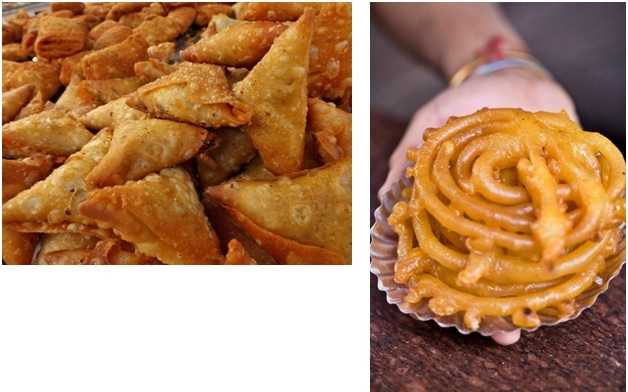What Would Your Dadi Say About Health Warnings On Your Jalebi And Samosa? How Food Labels May Change The Way India Eats
Total Views |

You walk into the AIIMS Nagpur canteen after a long morning lecture,
dreaming of a crisp samosa and a syrupy jalebi. But right there, above the
snack counter, is a big yellow warning board. It has a jalebi on it — coiled,
shiny, tempting — but with a red triangle next to it: “High in Sugar. Regular
Consumption May Lead to Diabetes and Heart Disease.”
Health Warnings On Snacks
In a first-of-its-kind move, the Indian Health Ministry has decided to
roll out visual health warnings on traditional Indian snacks, beginning with
AIIMS Nagpur. Yes, the samosa will now have a health warning label, much like
the kind you see on cigarette packs. The same goes for vada pav, chai biscuits,
pakoras, and of course, the humble jalebi. This is not a ban. Your favourite
snacks aren’t being snatched away. But every time you pick one, the government
wants you to think twice. They want you to remember that India’s growing health
crisis (the skyrocketing cases of obesity, type 2 diabetes, high blood
pressure, and cardiovascular disease) is quite literally, on your plate.
Samosas
By 2050, India could have 440 million people who are overweight or obese,
according to latest projections in The Lancet. That’s more than the entire
population of the United States. So, naturally, the government has decided it’s
time to act. The campaign will soon expand to other cities and campuses, making
cafeterias and food courts across India battlegrounds for the war on lifestyle
diseases.
Change In Desi Food Culture
Now imagine breaking the news to your dadi. “Dadi, did you know they’re
putting warning labels on jalebis?” She stops stirring the ghee in the pan,
looks at you like you’ve just insulted the entire family tree. “Jalebi?
Dangerous? Since when?” she asks. “We’ve been eating sweets for generations.
Did I ever have diabetes? Your nana lived till 84!”
This, right here, is where the real battle begins — the battle between
modern public health and cultural nostalgia. For decades, traditional Indian
food has been a source of pride, comfort, and celebration. Every major life
event (a wedding, a baby’s first steps, a festival, or even a job promotion)
has been marked with sweets. Ghee, sugar, oil were signs of prosperity. If
someone made “thin” kheer, we called it gareebon wali kheer.
So now, when the government decides to tag a jalebi as hazardous, it
isn’t just about public health; it's poking at an entire generation’s identity.
The generation that saw food as medicine (garam doodh for colds), joy (gajar ka
halwa on New Year’s), and even status (mithai boxes in gold foil). For them, a
warning sign next to their favourite snack feels like a slap on their sanskar.
Metabolism and Moderation
But here’s the thing Dadi may not understand: our generation lives
differently. We sit in front of laptops for 9 to 12 hours a day. We Uber
instead of walking. Our average steps per day barely cross 3,000 (ask your
fitness app). We sleep less, stress more, and binge-watch with chips and chai
at midnight. And while Dadi burned off her halwa calories by sweeping
courtyards and grinding masalas by hand, we don't burn ours.
Jalebis
So yes, even though Dadi’s ladoos came from love, not a factory, and her
jalebis were homemade and seasonal, our lifestyles no longer support daily
indulgences. That’s where the warning comes in. It’s not saying “don’t eat” —
it’s saying “don’t forget the consequences.” It’s also a nudge toward
accountability. You are what you eat. If you eat like you did in 1990, but move
like it’s 2025, you’ll end up in a hospital by 2030.
Will It Work?
Will people stop eating samosas because of a poster? Probably not
immediately. But that’s not the point. Just like cigarette warnings didn’t make
every smoker quit overnight, food warnings aren’t about instant results.
They’re about awareness. A trigger for a conversation. A child asking, “Mummy,
why does this biscuit have a red sticker?”
In countries like Chile and Mexico, similar “black box” labels led to
significant declines in the consumption of sugary drinks and junk food within
just a few years. Chile even saw a drop in childhood obesity. Imagine what
could happen if every school canteen, railway station, and office pantry in
India began showing these labels. Imagine if it nudged one teenager to skip the
fizzy drink, or one family to eat pakoras just on weekends instead of every
day.
The key isn’t to villainize samosas or jalebis — the key is moderation.
Enjoy them as a treat, not a staple. Make them at home, not every day. Let
sweets remain a celebration, not a habit. We also need to rethink how we love
someone. Do we show affection with food that slowly damages health, or with
food that sustains it? Maybe “Eat this, beta, I made it with love” can become
“Eat this, beta, I made it with millets and jaggery!”
The next time you reach for that vada pav and see a red label, don’t
panic. Just pause. Ask yourself: Is this a once-in-a-while thing, or a daily
diet? Call your granny and tell her, “Dadi, your mithai is still the best, but
today I’ll have just one piece instead of five.”

